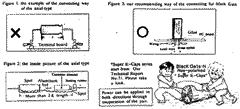 Black Gate-N Non-polarized
Super E-Caps
Black Gate-N Non-polarized
Super E-Caps
* Super E-Caps series started from technical Report No.71.
Figurc 2 is the inside picture of the development of the electrolytic capacitor above mentioned. Inside capacitor element is the same as an ordinary electrolytic cap which has the radial type of lead wires. The Lead wire of the negative side is welded spot to the one side of a flat ribbon wire that has more than 2L length, made of aluminum foil. Then the other side of the ribbon is also welded to the opposite side of an inside bottom. Its lead wire is made of iron because of the structural reason, therefore the element is connected by aluminum and iron to a circuit. However, these metals lower the quality for 30dB about the distortion value,and 30% about E.S.R. value. Especially the L-component of the earth side increases terribly, it reaches the worst level. Moreover, the connecting way is so unstable that is weak at vibration.
In short, this
style is out of date, but many people still believe it today. We
guess people are influenced by the appearance that looks easy connection
or by its sales copy.
We'vc asked many times
if there will be a schedule of producing such type of electrolytic capacitor.
However, we won't make it anytime in the future because of the above reasons.
Now, we're gonna introduce how to connect the radial type of a capacitor firmly to your hand made set. See figure 3. First, drill two holes in a PC board at an interval of the lead wires of the capacitor. Next, put eyelets into each of the hole. Then, glue the eyelets and the board with rubber adhesive. Finally, solder the root of the lead wires and the eyelets.
It will be better that to connect wireings and the lead wires as figure 3. The lead wires become the shortest ones, moreover the glue is effective enough for suppressing the vibration of the electrodes.
We recommend you to
connect BGs to a circuit with the way which we mentioned above. The
tone quality will grade up fantastically that beyond your imagination.
| Figure 1: the example of the connecting way of the axial type(left) | Figure 2: the inside picture of the axial type(right) | Figure 3: Our recommending way of the connecting for Black Gate(down left) |
 Black Gate-N Non-polarized
Super E-Caps
Black Gate-N Non-polarized
Super E-Caps
* Super E-Caps series started
from technical Report No.71.